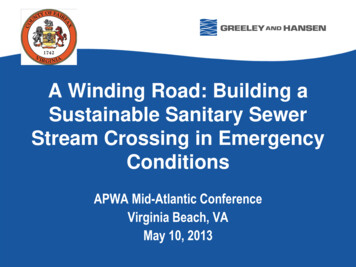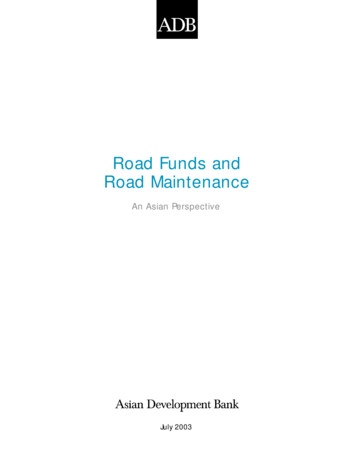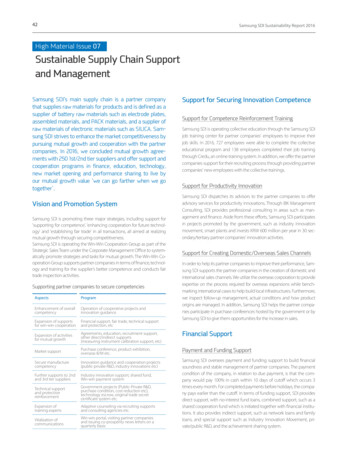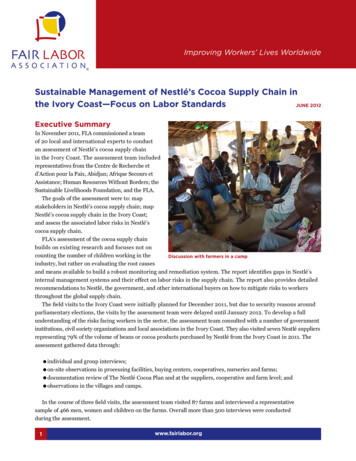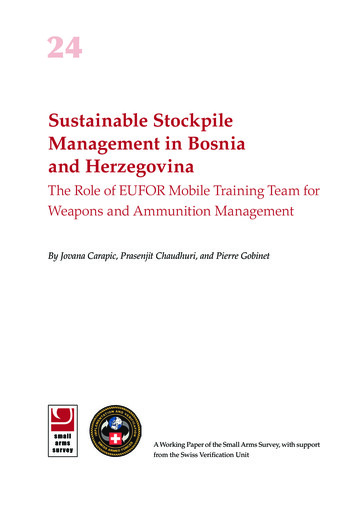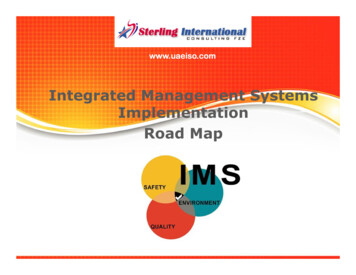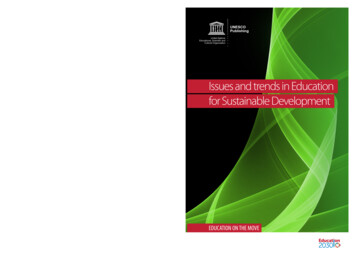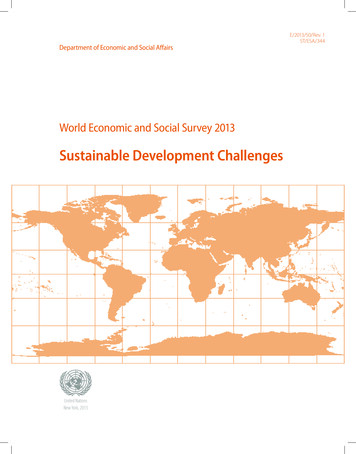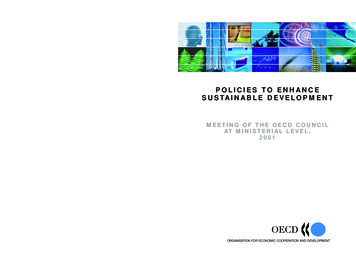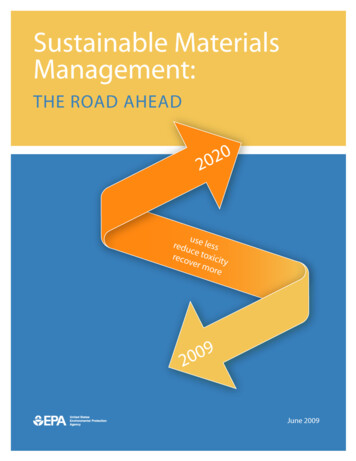
Transcription
AcknowledgementsTHE 2020 VISION WORKGROUPDerry Allen, US EPA National Center for Environmental InnovationShannon Davis, US EPA Region 9Priscilla Halloran, US EPA Office of Resource Conservation and RecoveryPeggy Harris, California Department of Toxic Substances ControlKathy Hart, US EPA Office of Pollution Prevention and ToxicsJennifer Kaduck, Georgia Department of Natural ResourcesAngela Leith, US EPA Office of Resource Conservation and RecoveryClare Lindsay, US EPA Office of Resource Conservation and RecoveryMark McDermid, Wisconsin Department of Natural ResourcesWayne Naylor, US EPA Region 3Sam Sasnett, US EPA Office of Pollution Prevention and ToxicsScott Palmer, US EPA Office of Resource Conservation and RecoveryKaren Sismour, Virginia Department of Environmental QualityPam Swingle, US EPA Region 4Contractor support provided by Ross & Associates Environmental Consulting, Ltd. andSRA International.EPA530 R 09 009
Table of ContentsExecutive Summary . iIntroduction: Our Material World . 1Chapter 1: A Resource Hungry World . 4Understanding the Flow of Materials. 4Trends in Global Material Consumption and Environmental Impact . 4Trends in U.S. Material Consumption and Environmental Impact . 7Global and U.S. Trends: Looking Ahead . 8Leading the U.S. to a More Sustainable Future: Materials Management . 10How Does Materials Management Differ From Current Approaches? . 13Chapter 2: Building an Analytic Framework. 18Developing the Framework . 18Applying the Framework to the U.S. Economy . 20What We Found . 22Conclusion . 23Chapter 3: Workgroup Recommendations for Achieving Sustainable MaterialsManagement . 27Recommendation 1: Promote efforts to manage materials and products on alife-cycle basis . 28Recommendation 2: Build capacity and integrate materials management approachesin existing government programs . 33Recommendation 3: Accelerate the broad, ongoing public dialogue on life-cyclematerials management . 37List of Figures and TablesFigure 1: Materials Consumption in the United States by Sector of Origin, 1975–2000 . 2Figure 2: The Flow of Materials . 5Figure 3: Framework for Examining Materials Management . 11Figure 4: Materials Management Approaches . 12Figure 5: Example of a Life-cycle Materials Management Approach for Packaging . 17Figure 6: U.S. Supply Chain Perspectives . 21Table 1: Summary of Top-Ranked Materials, Products, and Services. 25Appendix: Relative Ranking Technical Support Document(separate document)
Executive SummaryWe live in a material world. How our societyuses materials is fundamental to many aspectsof our economic and environmental future. Ifwe want the U.S. to be competitive in the worldeconomy, the sustainable use of materials mustbe our goal.Our key message is simple. Our use of materials is very large andincreasing with population and economicgrowth. Energy and water use accompanymaterials use. Our use of materials now challenges the capacity of the Earth – air, water and land – towithstand the many resulting environmental problems. This situation fundamentallyaffects many other aspects of our future, such as the economy, energy and climate. Weneed to fulfill our human needs and prosper while using less material, reducing toxicsand recovering more. Business as usual cannot continue. The public and private sectors have many of the tools that we need to manage materialsmuch more carefully than we typically do today. However, these tools are seldom usedto address the full life cycle of materials. This report describes specific measures thatEPA and state environmental agencies can take to: (1) promote efforts to managematerials and products on a life-cycle basis, using present authorities, (2) build ourcapacity to manage materials in the future, and (3) accelerate the public dialoguenecessary to start a generation-long shift in how we manage materials and create agreen, resilient and competitive economy. We should begin aggressively.Our Material WorldThe foundation that underlies the world economy, prosperity and a healthy environmentrests largely on how people extract and use the full range of materials that come from andreturn to the Earth such as wood, minerals, fuels, chemicals, agricultural plants andanimals, soil, and rock.The world at large and the United States in particular use vast amounts of materials andthose amounts are rapidly increasing.Executive Summary Page i
Î In the past 50 years, humans have consumed more resources than in all previoushistory.Î The U.S. consumed 57% more materials in the year 2000 than in 1975; the globalincrease was even higher.Î With less than 5% of the world’s population, the U.S. was responsible for about onethird of the world’s total material consumption in 1970-1995.Î In 1900, 41% of the materials used in the U.S. were renewable (e.g., agricultural,fishery, and forestry products); by 1995, only 6% of materials consumed wererenewable. The majority of materials now consumed in the U.S. are nonrenewable,including metals, minerals, and fossil-fuel derived products.Î Our reliance on minerals as fundamental ingredients in the manufactured products usedin the U.S.—including cell phones, flat-screen monitors, paint, and toothpaste—requiresthe extraction of more than 25,000 pounds of new nonfuel minerals per capita eachyear.Î This rapid rise in material use has led to serious environmental effects such as habitatdestruction, biodiversity loss, overly stressed fisheries, and desertification.Projections are that between 2000 and 2050, world population will grow 50%, globaleconomic activity will grow 500%, and global energy and materials use will grow300%. Commenting on the effects of material resource use on the environment, the headsof major research institutes in the United States, Germany, Japan, Austria, and theNetherlands have noted that “unless economic growth can be dramatically decoupledfrom resource use and waste generation, environmental pressures will increaserapidly. 1 ”The strategic importance of materials is causing many people to look very carefully at allaspects of the material life cycle that comprise our industrial practices and consumer habits.The material lifecycle begins with the extraction or harvesting of raw materials. Materialsare then transported and processed to create the products and services that drive oursociety. They are distributed, consumed, reused or recycled, and ultimately disposed.Each stage of this cycle requires energy and water as inputs and creates impacts on theenvironment. Because the stages are interrelated, it is important that sound approaches tomaterials use consider the entire life cycle. The price system, regulatory framework,technical information and human mindsets must all work together to enable and encouragelife-cycle materials management – an approach to serving human needs byusing/reusing resources most productively and sustainably throughout their lifecycles, generally minimizing the amount of materials involved and all theassociated environmental impacts.By considering system-wide impacts, life-cycle materials management casts a far broadernet than traditional waste and chemicals management approaches and represents a changeExecutive Summary Page ii
in how we think about environmental protection. There are many means by which life-cyclematerials management can be accomplished. For instance, careful industrial and productdesign that reduces virgin material use and reuses materials can reduce impacts throughoutthe system.While there are a number of existing EPA and state programs that are helping to move theU.S. toward a more material-efficient society, there is no comprehensive materialsmanagement strategy at the Federal level. Regulations and economic instruments seek toprevent or mitigate certain impacts, but rarely take meaningful account of upstream ordownstream effects.To accomplish the shift to life-cycle materials management, governments at all levels needto make systematic efforts to enable, encourage, and collaborate with all parts of society,including business and consumers, to ensure that materials are used more efficiently andeffectively. There is much work to be done, but there also is reason for modest optimism.An increasing number of industries and individual companies are taking a life-cycle view oftheir materials and processes and becoming more sustainable and competitive.Origin of This ReportIn 2002, EPA published “Beyond RCRA: Waste and Materials Management in the Year2020”—commonly referred to as the 2020 Vision. The 2020 Vision was the product of astate/EPA workgroup and was endorsed by EPA and state environmental and waste programofficials. One of the key findings was the need for society to shift focus away from wastemanagement toward materials management. Even before the Vision’s release, states andEPA had been moving in this direction and in the years that followed they have continued tomake progress.In January 2007 the directors of EPA’s waste and chemical programs convened the present2020 Vision Workgroup to develop a roadmap to accelerate the move toward sustainablematerials management.Building an Analytic FrameworkThe U.S. economy is a highly complex and intertwined system that transforms a fewhundred raw materials into thousands of products. It would be unrealistic to focus on andtransform all the materials and products consumed in an entire economy simultaneously.Instead, the Workgroup recommends a strategy that includes a few well-chosendemonstration projects to provide insights into applying integrated materials managementapproaches (including the need for better coordination of resources, product and wasteprograms). To help identify candidates for these demonstration projects, the Workgroupdeveloped a framework to relatively rank the materials, products and services consumed inthe U.S. from a life-cycle perspective, accounting for the environmental impacts, resourceExecutive Summary Page iii
use (material, energy, water), and waste. This framework reflects the Workgroup’s beliefthat these are the types of information that must be accounted for from a lifecycleperspective when applying materials management. Thirty-eight (38) materials, productsand services were identified as possible candidates for demonstration projects. These can beroughly grouped into construction and development, food products and services, forestry,metals, nonrenewable organics, textiles, and other products and services.RecommendationsThe Workgroup makes three major recommendations to EPA and state environmentalagencies. Some of these recommendations reflect points in international agreements underthe Organization for Economic Cooperation and Development (OECD) and the Group of 8(G8) endorsed by the United States in 2008.1. Promote efforts to manage materials and products on a life-cycle basis. EPA andstate environmental agencies should initiate demonstration projects on a few well-chosenmaterials and products to show the value of integrated materials management strategies.Further, these agencies should incorporate materials management as an important strategicapproach for addressing climate change and other environmental challenges. The focus ofexisting chemical and waste programs should be expanded to encompass life-cyclematerials management more fully.2. Build capacity and integrate materials management approaches in existinggovernment programs. EPA and state environmental agencies must ensure theavailability of data and decision tools needed to support life-cycle materials management,including necessary research. Materials management strategies should be integrated intoregulatory development, permitting and partnership programs. EPA and states shouldrecognize and support champions who make this happen.3. Accelerate the broad, ongoing public dialogue on life-cycle materialsmanagement. Governments alone cannot bring about the shift to life-cycle materialsmanagement. EPA and state environmental agencies should convene multi-stakeholdernational dialogues on materials management to create public awareness of theenvironmental consequences of material and product choices and accelerate the momentumtoward change at all levels. It also will be critical for the Agency to participate ininternational efforts related to sustainable material management.Executive Summary Page iv
These recommendations representparallel paths that should be taken atthe same time. Specific actionsdescribed under each recommendationare a mix of near term and long termefforts to develop the data, information,programs, policies, and partnershipsthat will begin to change the ways wethink about and use materials.These changes will not be easy. Thisreport is a roadmap to the year 2020 –eleven years away. While this is notenough time to complete the changesrecommended, it is enough time tomake substantial progress. Startingnow is critical because many of theissues we are facing require long-termsolutions that cannot be put into placequickly when a problem becomesobvious or acute. The recommendationscan be an important element of ournational strategy to address currenteconomic, energy, environment andclimate issues and set us on a course tobe more prosperous, competitive andresilient for years to come.RECOMMENDATIONSRECOMMENDATION 1: Promote efforts tomanage materials and products on a life-cyclebasis.1.1 Select a few materials/products for anintegrated life-cycle approach, and launchdemonstration projects.1.2 Expand the focus of existing environmentalprograms to encompass life-cycle materialsmanagement more fully.1.3 Promote specific materials managementapproaches that can help address climatechange.1.4 Promote greener products, productstewardship, and product-to-servicetransformations.1.5 Strengthen market signals to reduce waste andother adverse environmental impactsthroughout the life cycle of materials.RECOMMENDATION 2: Build capacity andintegrate materials management approachesin existing government programs.2.1 Establish and improve databases to promotematerials management.2.2 Improve decision tools to support life-cyclematerials management.2.3 Expand research and innovations supportprograms to promote materials management.2.4 Emphasize materials management in EPA andstate processes and procedures.2.5 Support and reward federal, state, tribal, andlocal champions for materials management andencourage collaboration.RECOMMENDATION 3: Accelerate the broad,ongoing public dialogue on life-cycle materialsmanagement.3.1 Stimulate a national conversation aboutmaterials management, engaging multiplenetworks.3.2 Open a dialogue on economic instruments toencourage better materials management.3.3 Create ways to share knowledge on materialsmanagement.Executive Summary Page v
Introduction:Our Material WorldWood, minerals, fuels, chemicals, agriculturalplants and animals, soil, rock and othermaterials form the foundation that underliesboth the economy and the environment.Climate change, energy policy, and theeconomy all create headlines, but the storiesthat follow often miss the point that all theseissues are, in part, symptoms of how we usematerials. It is becoming increasingly clearthat how we use materials is a large factor inenergy use, climate change and the economy, and an important issue in its own right.Therefore, if we want to address the issues behind the headlines, and if we want the U.S. tobe competitive in the world economy, sustainable use of materials must be our goal.The United States uses vast amounts of materials and these amounts are rapidlyincreasing—we consumed 57% more materials (by weight) in the year 2000 than we did in1975 (see Figure 1). As described in Chapter 1, the global increase in materials use washigher. Materials returning to the environment increased 26% from 1975 to 2000 and theamounts remaining in use (mainly as durable products, buildings and roads, or “netadditions to stock”) rose 83%. 2 Historically, population and economic growth and newtechnologies have translated almost automatically into increased use of materials, energyand water.No matter how one does the calculations, the implications of current patterns of materialuse for the environment (including climate), the economy and our survival are profound andunsustainable. We must change the historical relationship of materials, energy, growth andthe environment. When used carefully, materials hold the keys to enormous opportunity,both as our nation competes in the global economy and as we move into the 21st century.Used carelessly, materials hold another set of keys, which open equally large threats to ourhealth, our economy and our environment.The opportunities presented by sound life-cycle approaches to using materials are beingdemonstrated in many places today. During the past several years, many companies andorganizations have discovered ways to do what was previously thought improbable or evenimpossible. By changing the ways they use materials, they have found ways to lighten theirIntroduction Page 1
environmental impacts significantly while increasing profit. They are making the U.S. morecompetitive with products that are recognized as more sustainable.7,000ForestryMaterial Consumption (DMC)(million metric Material3,0002,000Metals e 1: Materials Consumption in the United States by Sector of Origin, 1975–2000Source: WRI Material Flows Database 2005Threats to our environment caused by the ways we use materials are all around us and arenot new. In 1992, world leaders participating in the Earth Summit declared that “aprincipal cause of the continued deterioration of the global environment is thesteady increase in materials production, consumption and disposal.” 3 In response,governments around the world, including the U.S., have acknowledged the goal ofsustainable material use, but have struggled with how to achieve it.This struggle about how best to manage materials demands a new level of awareness andcooperation within and between nations. The world shares a finite set of materials and othernatural resources. We must know and respect the limits in order to live together and thrivewithin our means.The current economic situation makes the opportunities and threats related to materialseven more significant than they were only a short time ago. We are at a moment whenmany peop
Î In the past 50 years, humans have consumed more resources than in all previous history. Î The U.S. consumed 57% more materials in the year 2000 than in 1975; the global increase was even higher. Î With less than 5% of the world’s population, the U.S. was responsible for about one- thir
